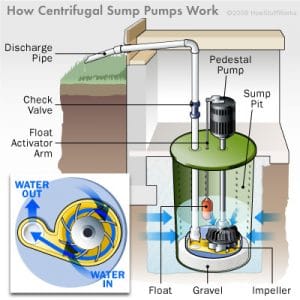Have you ever wondered how does a sump pump work? If not, you are in the right spot to get an idea about the working of sump pumps.
A Sump pump is nothing but a pump that is fixed on the bottom of the floor which is being used to discharge the accumulated water from the floor. These pumps are frequently used at the time of flooding or when the groundwater increases and floods the bottom area. Its work is to pump out the excess water from the basement and keep the area dry. People who live in ground floor or has a house in a very down region are the victims of this flood. A sump pump is a very useful tool for such people. Based on nature, Sump pumps can be divided into two types- namely submersible pump and pedestal pump.

Working of a sump pump:
- The submersible pump is generally immersed in the water. Therefore this pump lies at the bottom of the floor and has a capability to run inside the water.
- The sump pump works with the help of electricity through a GFCI (ground fault circuit interrupter) which protects from unwanted short circuits. Placing the switch in a dry area is always advisable.
- Groundwater is collected with the help of drain rocks which is laid at the bottom of the floor. By this process, the water level slowly starts increasing.
- With the help of perforated pipe or drain tile, the water is carried to the large sump tank or the sump pit. The size of the tank varies based on the location. The tank can be made of concrete, fibreglass, steel, tile and etc. This tank is located at the bottom of the floor.
- A flat sheet covers the bottom end of the pipe, which is specially designed to allow only the water to get into the pipe and avoids debris. Therefore the pump runs smoothly without getting struck by any substances.
- This sump pump tank has two holes in it. One for the collection of water from the perforated pipe and other for discharging the water out from the tank.
- When the sump pump tank is filled up to a certain level by water, the float activator or the pressure sensor hits the pump and the pump automatically gets started. This pump can also be activated manually when the water reaches a certain point.
- Proper maintenance of the pump should be taken care. If there is no proper maintenance the pump fails to get started when the water reaches a certain level.
- When the pump is activated the fan like device called the impeller starts rotating.
- Due to the deviating force, the impeller that spins will force the water towards the sides of the pump. As there are only two holes (one for collection and one for discharge) the water is forced out through the discharge hole.
- Therefore water is carried out through the discharge pipe and released out from your house. A check valve is fixed on the discharge pipe which helps the water to run one way and avoids the water from backflow.
- A pedestal pump is a pump that is placed in a dry place above the flooded area.
- Like submersible pump it works with electricity and but the worry of short circuit is eliminated as the pump is above the water level in a dry area.
- Due to heavy rain or due to increase in groundwater level, down areas are flooded with water and affects the normal life.
- Unlike the submersible pump, along inlet pipe (through which water is sucked out) is dropped into the flooded water.
- The pump is turned on manually and the water is sucked up through the pipe and released out in another area.
- The pedestal pump is usually louder than the submersible pump as it is laid outside the water.
Usually, when there is a flood due to rain or any natural disaster, it is very common that power will not be available till the water level decreases. In order to survive this situation, it is advisable to have a pump along with a battery or to have a generator for safety purpose.



